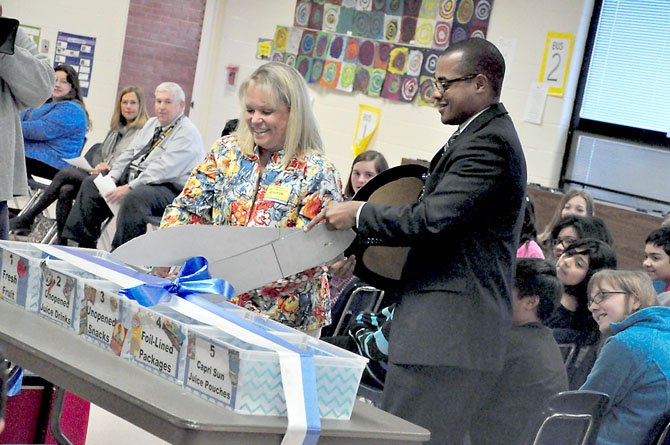Lisa Lombardozzi, president of LINK, pictured here with Marty Smith, Cluster One assistant superintendent for Fairfax County Public Schools, on March 12, 2012, as they cut the ribbon on the new food donation bins at Dranesville Elementary School. Photo by Alex McVeigh.
Herndon — After watching almost 6,000 pounds of food go to waste last year, the students and faculty of Dranesville Elementary School decided to do something about it. On Monday, March 12 the school cut the ribbon on their food recovery program, which will support LINK, a local nonprofit that provides food assistance to residents of Herndon, Sterling and Ashburn.
"Teachers Judi Ballenger and Aimee Conrad decided that there were a lot of students that expressed interest in helping people around them, so we got in touch with LINK," said Principal Kathy Manoatl. "And this has been a full effort from the students, every child at this school is involved 100 percent."
Students began tracking the amount of uneaten food that was thrown away, taking it out of the trash can and weighing it, while also keeping track of days of the week. They came to the conclusion that the school wasted 5,760 pounds of food last year, and as Manoatl said "they also decided it would be the last year that much went to waste."
Assistant Principal Willye Nance said once the students started keeping track of the wasted food, it really opened their eyes.
"They tracked the food, they graphed it and once they saw the numbers, it was very eye-opening," she said. "I think they saw that there was enough food that was thrown away here to really make a difference for hungry people in this area."
THE PROGRAM got a big break last November, when Rep. Frank Wolf (R-10) helped include language in the Department of Agriculture funding bill that would protect schools that donated food under the Good Samaritan Act. Prior to that, many schools threw away food, not wanting to expose themselves to liability should they donate it.
Wolf called it "a commonsense change that was long overdue" when the legislation was passed.
"The decision was really a catalyst for this program, because now we could be protected when we donated food," Manoatl said.
LINK donated a refrigerator to hold perishable items, and there are bins for unused Capri Sun juice pouches, unopened snacks, foil wrapped packages, unopened juice drinks and fresh fruit.
"Most of what we typically provide are nonperishable items, so we’re glad to be able to get fresh items in, and within 48 hours, they’ll be delivered to homes in need," said Lisa Lombardozzi, president of LINK. "Now we’ll start picking up food from Dranesville this week. The school has also done a lot of the leg work, the research, the guidelines for other schools to follow if they choose."
LINK serves 80 families a week, and Lombardozzi says the increased donations coming from Dranesville will allow them to stretch their budget even further.
Marty Smith, Cluster One assistant superintendent, said this program fulfilled a challenge facing every school, which is to become more involved in the community around them.
"What this school is doing is helping their students get an understanding of their place in the community," Smith said. "We know that if children start community service early, they won’t view it as just a fad, but as a part of who they are."
Nance said the students have already started forming an efficient "assembly line" to sort their unused food and beverages on their way out of the cafeteria.
"We’re doing this to ensure that the hungry people in this area are fed," said sixth-grader Anthony Rivera. "And we also want to show that we as children can make a difference."
More information on LINK can be found at www.linkagainsthunger.org.

